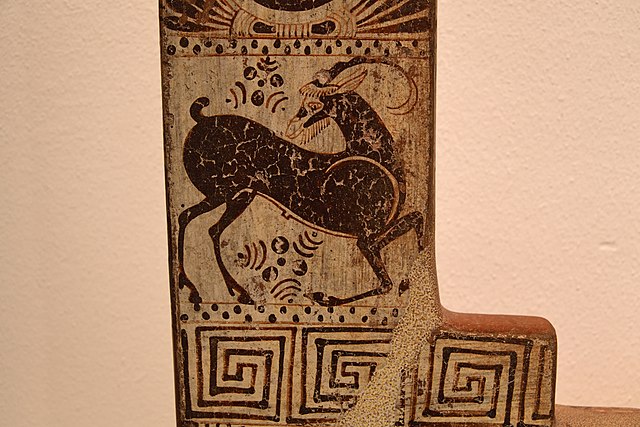
The Greek city of Klazomenai located near today’s Izmir (Smyrna) was the center of ceramic production in the ancient world.
Unique Ancient Greek ceramic figures along with a 2,500-year-old type of water-basin used for rituals have recently been discovered during excavations.
According to the excavation’s director Professor Yasar Ersoy, “The excavations unearthed a sink foot and its base decorated with fantastic mythological creatures and chariot races. This sixth-century B.C. artifact is about 2,500 years old. It is decorated with figures, embossed and painted in this way. It is the first of its kind.”
Klazomenai is located in modern Urla on the western coast of Anatolia and on the southern coast of the Gulf of İzmir about twenty miles west of İzmir.
The city was originally located on the mainland at Limantepe but probably relocated to the Karantina island just off the coast during the early fifth-century BC Ionian Revolt from the Persians.
Soon afterward, the Greek city of Chyton was founded on the mainland in the late fifth century BC. Both Greek cities had conflictual relations, but Alexander the Great eventually connected Karantina island to the mainland with a causeway, the remains of which are still visible.
An important Ancient Greek ceramic production center
The Klazomenai olive oil workshop, which is one of the earliest Ancient Greek workshops in the Aegean region that has survived thus far, exemplifies the existence of mass production in ancient times. It is dated to the sixth century B.C.

Ersoy added that “Klazomenai is considered to be one of the most important ceramic production centers in the region, especially in the Archaic period in the sixth century B.C.”
“In the excavations carried out here, we also find many…ceramics produced in workshops connected with the city,” Ersoy said.
“The sink we found is decorated with fantastic mythological creatures and chariot races. This artifact, which dates to the sixth century B.C., is about 2,500 years old. We do not know of an example embossed and painted like this sink.”
“At the same time, another type of vase, which is identified with Klazomenai, is a commercial amphorae,” Ersoy further added.
“Olive oil or wine used to be stored and carried in these amphorae. We see vases of this type in many places in a wide geography, mostly on the northern, eastern, and western coasts of the Black Sea and in the Western Mediterranean and Eastern Mediterranean. This shows us the dominant commercial activity of the city from the seventh century B.C. to the beginning of the sixth century B.C.”
Klazomenai in ancient times
Researchers generally trace the establishment of Klazomenai between the 11th and the 7th century BC. However, according to the most recent archaeological data, the Greek presence in Klazomenai goes back to the Late Bronze Age.
Recent archaeological excavations in the settlement have discovered an abundance of artifacts of the Late Bronze Age, as well as Mycenaean shells and Aeolian “bucchero” vessels, while there are also traces of the Protogeometric (10th century BC), in the southern part of the settlement. Many of these findings are houses at the Museum of Acropolis.
Accounts of the founding of the city are confusing. According to Strabo, the founder was Paralos, while Pausanias mentions Colophonius Parforos as an inhabitant.
Aelianos, on the contrary, considers the city to have been built by Niles, the son of the Athenian king Kodros.
Pausanias mentions that the original population of the city was mainly Peloponnesians from Kleones and Fleiunda, who fled after the descent of the Dorians and arrived at Klazomenai, having previously failed to establish themselves at the foot of Mount Ida.
The ancient Greek city was originally located near Limantepe, but the inhabitants, alarmed by the encroachment of the Persians, moved to the Karantina island of the bay and settled down there.
During the 6th century, Klazomenai was attacked by the King Alyattes of Lydia. In the 5th century, the town was for some time subject to the Athenians but about halfway through the Peloponnesian War (412 BC), it revolted.
After a brief resistance, however, it again acknowledged Athenian supremacy and repelled a Lacedaemonian attack. In 387 BC, Klazomenai and other cities in Asia were taken over by Persia, but the city continued to issue its own coins.

Many notable ancient figures originated from Klazomenai. The philosopher Anaxagoras (c. 510 to 428 BC), often referred to as “Anaxagoras of Klazomenai,” was born in the city, as was the earlier philosopher Hermotimus of Klazomenai.
In addition, Herodotos of Klazomenai was the first Klazomenian Olympic winner, his victory being in the boys’ foot-race. Finally, Scopelian or Skopelianos of Klazomenai was an ancient Greek sophist.
See all the latest news from Greece and the world at Greekreporter.com. Contact our newsroom to report an update or send your story, photos and videos. Follow GR on Google News and subscribe here to our daily email!



